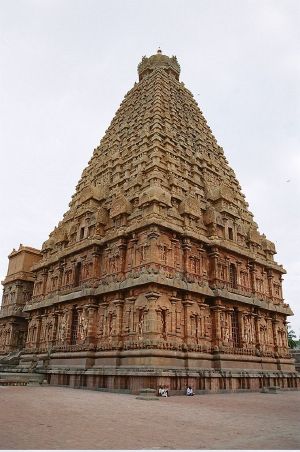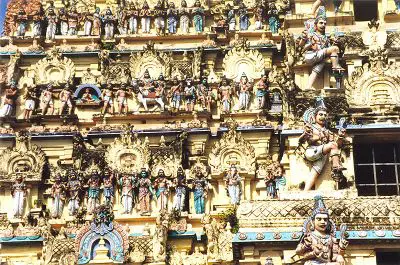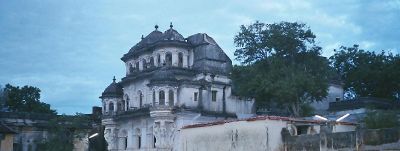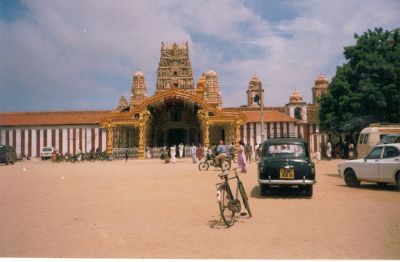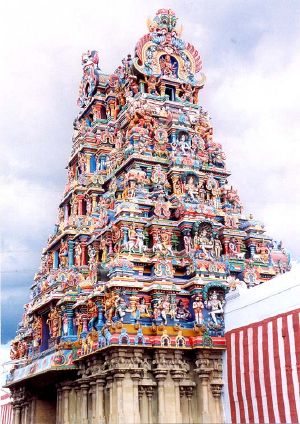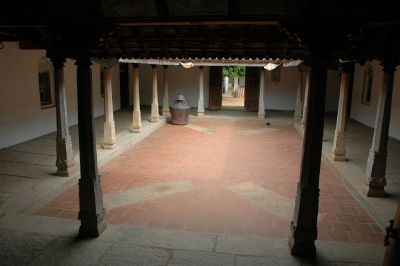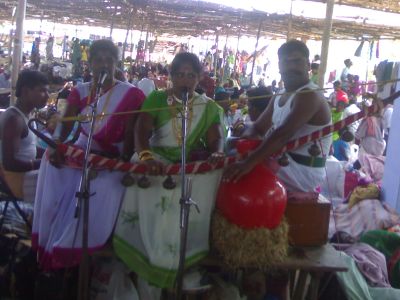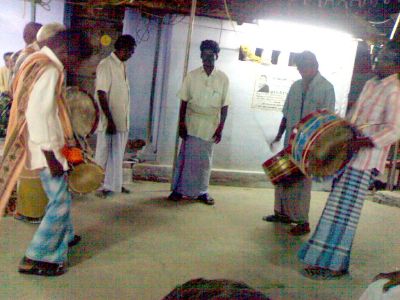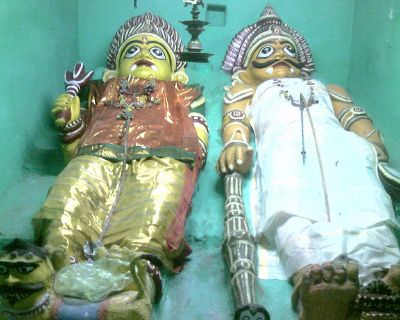Tamil people
| Tamils | ||||||||||||||||||
|---|---|---|---|---|---|---|---|---|---|---|---|---|---|---|---|---|---|---|
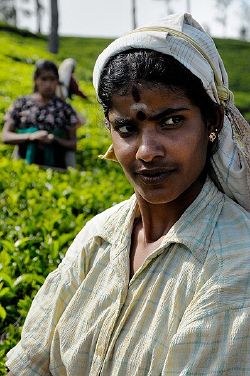
| ||||||||||||||||||
| Tamil woman working in a tea plantation in central Sri Lanka | ||||||||||||||||||
| Total population | ||||||||||||||||||
| 77,000,000  [1] | ||||||||||||||||||
| Regions with significant populations | ||||||||||||||||||
| ||||||||||||||||||
| Languages | ||||||||||||||||||
| Tamil | ||||||||||||||||||
| Religions | ||||||||||||||||||
| Hinduism, Christianity, Islam, Buddhism, Jainism | ||||||||||||||||||
| Related ethnic groups | ||||||||||||||||||
| Dravidian people · Brahui people · Kannadigas · Malayalis · Tamils · Telugus · Tuluvas · Gonds |
Tamil people, a Dravidian people from the Indian subcontinent, have a recorded history going back more than two millennia. The oldest Tamil communities live in southern India and north-eastern Sri Lanka. A number of Tamil emigrant communities resided scattered around the world, especially in central Sri Lanka, Malaysia, South Africa, Singapore, and Mauritius with more recent emigrants found in New Zealand, Australia, Canada, the United States, and Europe. An estimated 77 million Tamils live scattered around the world.
The art and architecture of the Tamil people encompass some of the greatest contributions of India to the art world. The music, the temple architecture and the stylized sculptures favored by the Tamil people remain live art forms, still learned and practiced. The classical language of Tamil, one of the oldest languages in India, has the oldest extant literature amongst other Dravidian languages.
Unlike many ethnic groups, Tamils experienced governance by more than one political entity during most of their history. Tamilakam, the traditional name for the Tamil lands, experienced political unity for only a brief period, between the ninth and twelfth centuries, under the Chola Dynasty. Enthnologists identity Tamil primarily by linguistic similarities, although in recent times the definition has been broadened to include emigrants of Tamil descent who maintain Tamil cultural traditions, even if they no longer regularly speak the language. Tamils ethnically, linguistically and culturally relate to the other Dravidian peoples of the Indian subcontinent.
History
Pre-historic period
The origins of the Tamil people, like those of the other Dravidian peoples, remain unknown, although genetic and archaeological evidence suggests a possible migration into India around 6000 B.C.E.[2] The megalithic urn burials, dating from around 1000 B.C.E. and onwards, which have been discovered at various locations in Tamil Nadu, notably in Adichanallur, provide the earliest clear evidence of the presence of the Tamil people in modern Tamil Nadu. Comparative excavations carried out in Adichanallur in Thirunelveli district and in Northern India have provided evidence of a southward migration of the Megalithic culture[3] These burials conform to the descriptions of funerals in classical Tamil literature in a number of details, and appear to be concrete evidence of the existence of Tamils in southern India during that period. In modern times, ancient Tamil literature like Sangam poetry and epics like Silapthigaaram have been interpreted as making references to a lost land known as Kumari Kandam.
Classical period
From around the third century B.C.E. onwards, three royal dynasties‚ÄĒthe Cholas, the Cheras and the Pandyas‚ÄĒrose to dominate the ancient Tamil country.[3] Each of those dynasties had its own realm within the Tamil-speaking region. Classical literature and inscriptions also describe a number of Velirs, or minor chieftains, who collectively ruled over large parts of central Tamil Nadu.[4] Wars between the kings and the chieftains were frequent, as were conflicts with ancient Sri Lanka.[5] Those wars appear to have been fought to assert hegemony and demand tribute, rather than to subjugate and annex those territories. The kings and chieftains served as patrons of the arts, and a significant volume of literature exists from that period. The literature shows that many of the cultural Tamil practices date back to the classical period.[4]
Agriculture played a vital role during this period, evidence suggesting that they built irrigation networks as early as second century C.E. Internal and external trade flourished, and evidence exists of significant contact with Ancient Rome. Large quantities of Roman coins and signs of the presence of Roman traders have been discovered at Karur and Arikamedu.[6] Evidence exists suggesting that Pandya kings sent at least two embassies to the Roman Emperor Augustus. Potsherds with Tamil writing have been found in excavations on the Red Sea, suggesting the presence of Tamil merchants there. An anonymous first century traveler's account written in Greek, Periplus Maris Erytraei, describes the ports of the Pandya and Chera kingdoms and their commercial activity in great detail. Periplus also indicates that the ancient Tamils exported chiefly pepper, malabathrum, pearls, ivory, silk, spikenard, diamonds, sapphires, and tortoiseshell.[7]
The classical period ended around the fourth century C.E. with invasions by the Kalabhra, referred to as the kalappirar in Tamil literature and inscriptions,[8] described as evil kings and barbarians coming from lands to the north of the Tamil country. 'Kalabhraas were denounced as 'evil kings' (kaliararar)[3] That period, commonly referred to as the Dark Age of the Tamil country, ended with the rise of the Pallava dynasty.[8]
Imperial and post-imperial periods
Although the Pallava records trace to the second century C.E., they arose to prominence as an imperial dynasty in the sixth century.[9] Evidence suggests that the dynasty had been non-Tamil in origin, although they rapidly adopted the local culture and the Tamil language. The Pallavas sought to model themselves after great northern dynasties such as the Mauryas and Guptas. They therefore transformed the institution of the kingship into an imperial one, and sought to bring vast amounts of territory under their direct rule. The Pallavas, initially Buddhists, later converted to Hinduism. They encouraged the Bhakti movement, which had risen to counter the growing influence of Jainism and Buddhism. The Pallavas pioneered the building of large, ornate temples in stone which formed the basis of the Dravidian temple architecture.
The resurgent Cholas overthrew the Pallava dynasty in the ninth century. The Cholas become dominant in the tenth century and established an empire covering most of southern India and Sri Lanka.[9] The empire had strong trading links with China and Southeast Asia.[10] The Cholas' navy conquered the South Asian kingdom of Sri Vijaya in Sumatra and continued as far as Thailand and Burma. Chola power declined in the twelfth and thirteenth centuries, and the Pandya dynasty enjoyed a brief period of resurgence thereafter during the rule of Sundara Pandya.[9] Repeated Muslim invasions from the fifteenth century onwards placed a huge strain on the empire's resources, the dynasty coming to an end in the sixteenth century.[3]
The western Tamil lands became increasingly politically distinct from the rest of the Tamil lands after the Chola and Pandya empires lost control over them in the thirteenth century. They developed their own distinct language and literature, which increasingly grew apart from Tamil, evolving into the modern Malayalam language by the fifteenth century.[11]
No major empires arose thereafter, and for a while a number of different local chiefs, such as the Nayaks of the modern Maharashtra ruled Tamil Nadu and Andhra Pradesh regions. From the seventeenth century onwards, European powers began establishing settlements and trading outposts in the region. The British, French and Danish in the eighteenth century fought a number of battles for control of the region, and by the end of the eighteenth century most of Tamil Nadu came under British rule.
Tamils in Sri Lanka
Little consensus exists on the history of the Tamil-speaking parts of Sri Lanka prior to the Chola period. Some Sinhala historians argue that the Tamil had no organised presence in Sri Lanka until the invasions from southern India in the tenth century, whereas many Tamil historians contend that Tamils represent the original inhabitants of the island, called Araipadi and Elapadi. The historical evidence proves neither case.
The historical record does establish that the Tamil kingdoms of India engaged closely in Sri Lankan affairs from about the second century B.C.E.[12][5] Evidence exists of early Tamil traders in Anuradhapura. Tamil adventurers invaded the island as far back as 100 B.C.E. Tamil wars against Sri Lanka culminated in the Chola annexation of the island in the tenth century, lasting until the latter half of the eleventh century.[12][5][13]
The re-establishment of the Polonnaruwa monarchy in the late eleventh century followed the decline of Chola power in Sri Lanka. In 1215, the Arya Chakaravarthi dynasty established an independent Jaffna kingdom in the Jaffna peninsula and parts of northern Sri Lanka. Alagakkonara, a man from a family of Malayali merchants who had become the chief minister of the Sinhalese king Parakramabahu V (1344‚Äď1359), halted the Arya Chakaravarthi expansion into the south. Alagakkonara built a fortress at Kotte and held the Arya Chakravarthi army there while he defeated the invading fleet at Panadura, southwest of Kotte. A descendant of Alagakkonara (Tamil Alagakonar) later became King of the Sinhalese,[12] but the Ming admiral Zheng He deposed that line in 1409. The Arya Chakaravarthi dynasty ruled over large parts of northeast Sri Lanka until 1619, when the Portuguese conquered Sri Lanka. Then the Dutch took the coastal areas of the island, until in 1796 those became part of the British Empire.
Modern period
British colonists consolidated the Tamil territory in southern India into the Madras Presidency before integrating the region into British India. Similarly, the Tamil parts of Sri Lanka joined with the other regions of the island in 1802 to form the Ceylon colony, Ceylon remaining in political union with India and Sri Lanka after their independence, in 1947 and 1948 respectively.
When India became independent in 1947, Madras Presidency became the Madras State, comprised of present-day Tamil Nadu, coastal Andhra Pradesh, northern Kerala, and the southwest coast of Karnataka. The state subsequently split along linguistic lines. In 1953, the northern districts formed Andhra Pradesh. Under the States Reorganization Act in 1956, Madras State lost its western coastal districts, with the Bellary and South Kanara districts ceded to Mysore state. Kerala formed from the Malabar district and the former princely states of Travancore and Cochin. In 1968, Madras State became Tamil Nadu.
Initially, some Tamil demanded an independent Tamil state following the adoption of the federal system. The Indian constitution granted significant autonomy to the states, and protests by Tamils in 1963 led to the government adopting a new policy called the "three language formula," which led to Tamils in India becoming increasingly satisfied with the federal arrangement, support for secession or independence today nearly disappearing.
In Sri Lanka, the unitary arrangement led to a growing belief among some Tamils of discrimination by the Sinhalese majority. That resulted in a demand for federalism, which in the 1970s grew into a movement for an autonomous Tamil country. The situation deteriorated into civil war in the early 1980s. A ceasefire in effect since 2002 broke down in August 2006 amid shelling and bombing from both sides.
Geographic distribution
Indian Tamils
Most Indian Tamils live in the state of Tamil Nadu. They form the majority in the union territory of Pondicherry, a former French colony. Pondicherry comprises a subnational enclave situated within Tamil Nadu. Tamil communities exist in other parts of India, most emerging fairly recently, dating to the colonial and post-colonial periods, but some‚ÄĒparticularly the Hebbar and Mandyam Tamils of southern Karnataka, the Tamils of Palakkad in Kerala, and the Tamils of Pune, Maharashtra‚ÄĒdate back to at least the medieval period.
Sri Lankan Tamils

Two groups of Tamils live in Sri Lanka today. The first, known as the Sri Lankan Tamils, either descended from the Tamils of the old Jaffna kingdom or migrated to the East coast. The second, known as the Indian Tamils or Hill Country Tamils, descended from bonded labourers sent from Tamil Nadu in the nineteenth century to work in tea plantations.[12] Ceylon Tamils mostly live in the Northern and Eastern provinces and in the capital of Colombo, whereas hill-country Tamils largely live in the central highlands. The Hill Country Tamils and Ceylon Tamils historically have seen themselves as separate communities. In 1949, the United National Party Government, including G. G. Ponnambalam, a leader of the Tamil Congress and of the Sri Lankan Tamils, stripped the Indian Tamils of their nationality, along with their right to vote. Prominent Tamil political leaders such as S. J. V. Chelvanayakam and his Tamil opposition party opposed that move.[14]
Under an agreement between the Sri Lankan and Indian governments in the 1960s, around 40 percent of Hill Country Tamils received Sri Lankan nationality, and many of the remainder repatriated to India. The ethnic conflict has led to the growth of a greater sense of common Tamil identity, and the two groups have become more supportive of each other. By the 1990s most Indian Tamils had received Sri Lankan citizenship.[12]
A significant Tamil-speaking Muslim population lives in Sri Lanka. Unlike Tamil-speaking Muslims from India, they reject the ethnic Tamils identity, usually listed by the government as a separate ethnic group in official statistics.[12]
Tamil emigrant communities
Significant Tamil emigration began in the eighteenth century, when the British colonial government sent many poor Tamils as indentured laborers to far-off parts of the Empire, especially Malaya, South Africa, Fiji, Mauritius and the Caribbean. At about the same time, many Tamil businessmen also immigrated to other parts of the British Empire, particularly to Burma and East Africa. Many Tamils still live in those countries, and the Tamil communities in Singapore, Reunion Island, Malaysia and South Africa have retained much of their culture and language. Many Malaysian children attend Tamil schools, and a significant portion of Tamil children in Mauritius and Reunion have been raised with Tamil as their first language. In Singapore, Tamil students learn Tamil as their second language in school, with English as the first. To preserve the Tamil language, the Singapore government has made it a national language despite Tamils comprising only about 10 percent of the population, and has also introduced compulsory instruction of the language for Tamils. Other Tamil communities, such as those in South Africa and Fiji, no longer speak Tamil as a first language, but still retain a strong Tamil identity, understanding the language, while most elders speak it as a first language.
A large emigration also began in the 1980s, as Sri Lankan Tamils sought to escape the ethnic conflict. Those recent emigrants have most often fled to Australia, Europe, North America, and Southeast Asia.[15]
Many young Tamil professionals from India have also immigrated to Europe and the United States in recent times in search of better opportunities. Those new immigrant communities have established cultural associations to protect and promote Tamil culture and language in their adopted homes.
Culture
Language and literature

Tamils have strong feelings towards the Tamil language, often venerated in literature as "TamilŐ≤anŐ≤nŐ≤ai," "the Tamil mother".[16] Historically, and contemporarily, Tamil language has been central to the Tamil identity. Like the other languages of South India, Tamil is a Dravidian language, unrelated to the Indo-European languages of northern India. The language has been far less influenced by Sanskrit than the other Dravidian languages, and preserves many features of Proto-Dravidian, though modern-day spoken Tamil in Tamil Nadu, freely uses loanwords from Sanskrit and English. Tamil literature possesses considerable antiquity, the government of India recognizing it as a classical language.
Classical Tamil literature, ranging from lyric poetry to works on poetics and ethical philosophy, has distinct differences from contemporary and later literature in other Indian languages, and represents the oldest body of secular literature in South Asia.[17] Notable works in classical Tamil literature include the Tirukkural, by Tiruvalluvar, the five great Tamil epics, and the works of Auvaiyar. The written language has changed little over the years, with the result that much of classical literature remains easily accessible to modern Tamils and continues to influence modern Tamil culture.
Modern Tamil possesses a diverse body of literature including: Indian Nationalism, in the works of Subramanya Bharathi; historical romanticism, by Kalki Krishnamurthy; radical and moderate social realism, by Pudhumaipithan and Jayakanthan; and feminism, by Malathi Maithri and Kutti Revathi. Sujatha, an author whose works range from romance novels to science fiction, stands as one of the most popular modern writers in Tamil. Sri Lankan Tamil writers have produced several works reflecting the civilian tragedy caused by decades of war. A diaspora literature has been emerging in Tamil.
The Tamil people use a number of regional dialects that vary among regions and communities. Tamil dialects mainly differentiate by the disparate phonological changes and sound shifts that have evolved from Old Tamil. Although most Tamil dialects differ insignificantly in their vocabulary, a few exceptions exist. The dialects spoken in Sri Lanka retain many words seldom used in daily conversation in India, while using many other words slightly differently. The dialect of the Iyers of Palakkad, with a large number of Malayalam loanwords, has been influenced by Malayalam syntax, and has a distinct Malayalam accent. The Sankethi, Hebbar, and Mandyam dialects, the former spoken by groups of Tamil Iyers, and the latter two by Vaishnavites who migrated to Karnataka in the eleventh century, retains many Vaishnavite religious and spiritual values. Although not a dialect, the Tamil spoken in Chennai infuses English words, creating Madras Bashai (Madras language).
Visual art and architecture
Most traditional Tamil art take a religious form usually centering on Hinduism, although the religious element often only serves as a means of representing universal‚ÄĒand, occasionally, humanist‚ÄĒthemes.[18]
Tanjore painting, originating in Thanjavur in the ninth century, represents the most important form of Tamil painting. The artist paints the image, using dyes, on cloth coated with zinc oxide, then decorates the painting with semi-precious stones as well as silver or gold thread. Painting employed temple wall murals uses a style related in origin, but that exhibits significant differences in execution, most notably the murals on the Meenakshi temple, of Madurai. Tamil art, in general, has earned a reputation for its stylistic elegance, rich colors, and attention to small details.
Tamil sculpture ranges from elegant stone sculptures in temples, to bronze icons with exquisite details. Art historians consider the medieval Chola bronzes one of India's greatest contributions to the world art. Unlike most Western art, the material in Tamil sculpture does not influence the form taken by the sculpture; instead, the artist imposes his/her vision of the form on the material.[19] As a result, one often sees in stone sculptures flowing forms that usually reserved for metal.[20] As with painting, those sculptures show a fine eye for detail. The artist takes great care in sculpting the minute details of jewelery, worn by the subjects of the sculpture. The cave sculptures at Mamallapuram and the bronzes of the Chola period present remarkable examples of the technique. The depiction of Shiva as Nataraja, in a dance posture with one leg upraised, and a fiery circular halo surrounding his body represents a popular motif in the bronzes.
Tamil temples, often simply treated as sculptures on a grand scale, host high spires known as Gopura, consisting of a number of stepped levels, and the vimanam, which rises above the sanctum sanctorum. During the Chola period, the vimanams had more prominence, as seen in the Brihadńęsvara temple of Thanjavur. During the Nayak period, the spires became progressively more elaborate and ornate, as exemplified by the Meenakshi Temple in Madurai, while the vimanam became much smaller. From the thirteenth century onwards, the entrance gates to the temples, called gopurams in Tamil, also began to grow larger, and more elaborate. The temples at Chidambaram and Srirangam have particularly impressive gopurams, covered with sculptures and reliefs of various scenes and characters from Hindu mythology.
As with Indian art in general, Tamil art traditionally resists portraiture or realism. Artists place primary emphasis on the representation of ideal prototypes, and on depicting the symbols associated with the theme of the artistic work. Small details, such as the direction a hand faces, the animals or trees portrayed, or the time of day depicted, convey critically subtle meanings.
Performing arts
The traditional Tamil performing arts have ancient roots. The royal courts and temples have been centers for the performing arts since the classical period, and possibly earlier. Descriptions of performances in classical Tamil literature and the Natya Shastra, a Sanskrit treatise on the performing arts, indicate a close relationship between the ancient and modern artforms. A performance in the Tamil tradition aims to bring out the rasa, the flavor, mood, or feeling, inherent in the text, its quality measured by the extent to which it induces the mood in the audience.
Tamil shares a classical musical tradition, called Carnatic music, with the rest of South India, primarily oriented towards vocal music, with instruments functioning either as accompaniments, or as imitations of the singer's role. Ancient Tamil music, stemming from the long traditions of classical literature and Cilappatikaram, played a major part in the evolution of Carnatic music. Carnatic music organizes around the twin notions of melody types (rńĀgam), and cyclical rhythm types (thńĀŠł∑am). Unlike the northern Hindustani music tradition, carnatic music has an almost exclusively religious quality. In sharp contrast with the restrained and intellectual nature of carnatic music, Tamil folk music tends toward the exuberant. Popular forms of Tamil folk music include the Villuppattu, a form of music performed with a bow, and the Naattupurapaattu, ballads that convey folklore and folk history.
Bharatanatyam represents the dominant classical dance among Tamils, performative rather than participative. The dance constitutes an exposition of the story contained in a song, usually performed by one performer on stage with an orchestra of drums, a drone, and one or more singers backstage. The dancers tell the story through a complicated combination of mudras (hand gestures), facial expressions, and body postures.
Karakattam constitutes the most notable of Tamil folk dances. The dancers perform the dance, in its religious form, in front of an image of the goddess Mariamma. The dancer bears, on his or her head, a brass pot filled with uncooked rice, decorated with flowers and surrounded by a bamboo frame, and tumbles and leaps to the rhythm of a song without spilling a grain. Dancers usually perform karakńĀŠĻ≠ŠĻ≠amto to a special type of song known as temmanguppattu, or thevar pattu, a folk song in the mode of a lover speaking to his beloved, to the accompaniment of a nadaswaram and melam. Other Tamil folk dances include mayilattam, where the dancers tie a string of peacock feathers around their waists; oyilattam, danced in a circle while waving small pieces of cloth of various colors; poykkal kuthiraiyaattam, in which the dancers use dummy horses; manaattam, in which the dancers imitate the graceful leaping of deer; paraiyattam, a dance to the sound of rhythmical drumbeats; and thippanthattam, a dance involving playing with burning torches.[21] Four to eight women perform the kuravanci, taking the form of a type of dance-drama. A woman opens the drama by playing the part of a female soothsayer of a wandering kurava, tribe, who tells the story of a lady pining for her lover.
The therukoothu, a form of village theater or folk opera, literally means "street play." Traditionally performed in village squares, the dancers use the street setting and very simple props. The performances involve songs and dances, and the stories can be either religious or secular. The performances have an informal air, performers often interacting with the audience, mocking them, or involving them in the dialogue. TherukkŇęthu has, in recent times, been very successfully adapted to convey social messages, such as abstinence and anti-caste criticism, as well as information about legal rights, and has spread to other parts of India.
The village of Melatur, in Tamil Nadu, has a special type of performance, called the bhagavatamela, in honor of the local deity, performed once a year, and lasting all night. Tamil Nadu also has a well developed stage theater tradition, which has been heavily influenced by western theatre. A number of theatrical companies exist, with repertoires including absurdist, realist, and humorous plays.
Both classical and folk performing arts survive in modern Tamil society. Tamil people in Tamil Nadu also have a passion for films. The Tamil film industry, commonly dubbed Kollywood, constitutes the second-largest film industry in India.[22] Tamil cinema has earned a reputation for both its technical accomplishments, and its artistic and entertainment value. The overwhelming majority of Tamil films contain song and dance sequences. Tamil film music, a popular genre in its own right, often liberally fuses elements of carnatic, Tamil folk, North Indian styles, hip-hop, and heavy metal. Famous music directors of the late twentieth century included M. S. Viswanathan, Ilayaraaja, and A. R. Rahman.
Religion
About 90 percent of the population of Tamil Nadu declare themselves Hindu. Christians and Muslims account for five percent each. Most of the Christians belong to the Roman Catholic Church. About one-third of the Muslim population speak Urdu and two-thirds speak Tamil. Tamil Jains number only a few thousand now.[23] Tamil Hinduism, like other regional varieties of Hinduism, has many peculiarities. Murugan, probably the same as Karthikeya, the son of Siva, but who may in origin have been a different deity, and has taken on a distinctly local character, stands as the most popular deity. The worship of Amman, also called Mariamman, thought to have been derived from an ancient mother goddess, prevails among Hindus.<ref.Bala N. Aiyer, Principles and Practice of Hindu Religion ‚Äé(Independently published, 2018, ISBN 978-1729229620).</ref> Many Tamils worship KanŐ≤nŐ≤agi, the heroine of the CilappatikńĀrŐ≤am, worshipped as PaŠĻ≠ŠĻ≠inŐ≤i, particularly in Sri Lanka. Many temples and devotees of Vishnu, Shiva, Ganapathi, and the other common Hindu deities exist.
Pongal, a harvest festival that occurs in mid-January, and Varudapirappu, the Tamil New Year, which occurs around mid-April, represent the most important Tamil festivals, celebrated by almost all Tamils regardless of religion. Tamils celebrate the Hindu festival Deepavali with fanfare; other local Hindu festivals include Thaipusam, Panguni Uttiram, and Adipperukku. While the Cauvery region celebrates Adiperukku with more pomp in than in other regions, the southern districts of Kanyakumari, Tirunelveli, and Thoothukudi predominantly celebrate the Ayyavazhi Festival, Ayya Vaikunda Avataram.
In rural Tamil Nadu, many local deities, called aiyyanŐ≤ńĀrs, villagers worship the spirits of local heroes whom they believe protect the village from harm. Their worship often centers around nadukkal, stones erected in memory of heroes who died in battle. Classical literature frequently mentions that form of worship, seemingly the surviving remnants of an ancient Tamil tradition.
Saivism has a particularly strong following in the North. The Alvars and Nayanars, predominantly Tamils, played a key role in the renaissance of Bhakti tradition in South India. In the tenth century, the philosopher Ramanuja, who propagated the theory of Visishtadvaitam, brought many changes to worshiping practices, creating new regulations on temple worship, and accepted lower-caste Hindus as his prime disciples.
Scholars believe Christianity came to Tamil Nadu with the arrival of Saint Thomas the apostle, with the number of Tamil Christians growing during the colonial period. Many Tamils adhere to the Catholic, Protestant, and Syrian Orthodox faiths. The majority of Tamil muslims pledge allegiance to either mainstream Sunni or the Sufi branch.
Cuisine
Tamil cuisine represents one of the oldest vegetarian culinary heritages in the world. Rice, the major staple food in most of Tamil, usually served steamed with about two to six accompanying items, typically including sambar, dry curry, rasam, kootu, and thayir (curd) or moru (whey or buttermilk).
Tiffin (light meals) usually include one or more of Pongal, Dosai, idli, Vadai along with sambar. Families often enjoy chutney as a breakfast or evening snack. Ghee (clarified butter called neyyi in Tamil, flavors the rice when eaten with dhal or sambar, but not with curds or buttermilk. Morkulambu, a dish often spiced with moru, popular among Tamil with steamed rice.
Each geographical area where Tamils live has developed its own distinct variant of the common dishes plus a few dishes distinctly native to itself. The Chettinad region, comprising of Karaikudi and adjoining areas, enjoys both traditional vegetarian dishes, like appam, uthappam, paal paniyaram, and non-vegetarian dishes, made primarily using chicken.
Martial arts
Tamil in Tamil Nadu and Kerala partice a variety of martial arts including Kuttu Varisai, Varma Kalai, Silambam Nillaikalakki, Maankombukkalai (Madhu) and Kalarippayattu. The weapons used include Silambam, Maankombukkalai, Yeratthai Mulangkol (double stick), Surul Pattai (spring sword), Val Vitchi (single sword), and Yeretthai Val (double sword).
The ancient Tamil art of unarmed bullfighting, popular amongst warriors in the classical period,[24] has also survived in parts of Tamil Nadu, notably Alanganallur near Madurai, known as JallikaŠĻ≠ŠĻ≠u or ma√ĪcuviraŠĻ≠ŠĻ≠u, with events held once a year around the time of the Pongal festival.
Notes
- ‚ÜĎ Top 30 Languages by Number of Native Speakers Ethnologue: Languages of the World, 15th ed. 2005. via Vistawide - World Languages & Cultures. Retrieved January 18, 2025.
- ‚ÜĎ Gadgil et al. "Peopling of India." In D. Balasubramanian and N. Appaji Rao (eds.), The Indian Human Heritage (Orient Longman, 1998, ISBN 8173711283).
- ‚ÜĎ 3.0 3.1 3.2 3.3 Nilakanta Sastri and G. Srinivasachari, Advanced History of India (Bombay: Allied Publishers, 2018, ISBN 8170231450).
- ‚ÜĎ 4.0 4.1 K. Sivathamby, Early South Indian Society and Economy: The Tinai Concept. Social Scientist 3 (5)(December 1974): 20‚Äď37.
- ‚ÜĎ 5.0 5.1 5.2 G.C. Mendis, Ceylon Today and Yesterday (Colombo: Lake House, 1995, ISBN 978-9555520966).
- ‚ÜĎ M.G.S. Narayanan, The Role of Peasants in the Early History of Tamilakam in South India. Social Scientist 16(9) (September 1988): 17‚Äď34.
- ‚ÜĎ The term Periplus refers to the region of the eastern seaboard of South India as Damirica - The Periplus of the Erythraean Sea: Travel and Trade in the Indian Ocean by a Merchant of the First Century. Ancient History Sourcebook. Fordham University. Retrieved January 19, 2025.
- ‚ÜĎ 8.0 8.1 The Indian Geographical Journal (Indian Geographical Society, 1941), 69.
- ‚ÜĎ 9.0 9.1 9.2 Vincent Arthur Smith, The Early History of India (London: The Clarendon press, 1904), 336‚Äď358.
- ‚ÜĎ Philip D. Curtin, Cross-Cultural Trade in World History (Cambridge University Press, 1984, ISBN 0521269318), 101.
- ‚ÜĎ Malayalam Omniglot. Retrieved January 19, 2025.
- ‚ÜĎ 12.0 12.1 12.2 12.3 12.4 12.5 C.R. de Silva, Sri Lanka - A History (New Delhi, Vikas Publishing House, 1997, ISBN 8125904611)
- ‚ÜĎ Vincent Arthur Smith, The Oxford History of India (Oxford, Oxford University Press, 1958, ISBN 0195612973).
- ‚ÜĎ Missed Opportunities and the Loss of Democracy University Teachers for Human Rights (Jaffna) UTHR(J). Retrieved January 19, 2025.
- ‚ÜĎ Christopher McDowell, A Tamil Asylum Diaspora: Sri Lankan Migration, Settlement and Politics in Switzerland (New York: Berghahn Books, 1996, ISBN 1571819177).
- ‚ÜĎ Sumathi Ramaswamy, Passions of the Tongue: Language devotion in Tamil India 1891‚Äď1970 (Delhi: Munshiram, 1998, ISBN 8121508517).
- ‚ÜĎ George L. Hart, The Poems of Ancient Tamil: Their Milieu and their Sanskrit Counterparts (Berkeley: University of California Press, 1975, ISBN 0520026721).
- ‚ÜĎ A.K. Coomaraswamy, Figures of Speech or Figures of Thought (World Wisdom, 2007, ISBN 978-1933316345).
- ‚ÜĎ Carmel Berkson, "II The Life of Form," in The Life of Form in Indian Sculpture (Abhinav Publications, 2000, ISBN 8170173760).
- ‚ÜĎ Rama Sivaram, Early Chola Art: Origin and Emergence of Style (New Delhi: Navrang, 1994, ISBN 8170130794).
- ‚ÜĎ Manorma Sharma, Folk India: A Comprehensive Study of Indian Folk Music and Culture, Vol. 11 (New Delhi: Sundeep Prakashan, 2004, ISBN 978-8175741423).
- ‚ÜĎ Tom Templeton, The states they're in. The Guardian (November 26, 2006). Retrieved January 19, 2025.
- ‚ÜĎ Jains in Tamil Nadu totaled 88,000 in 2001. Census Tamil Nadu. Directorate of Census Operations. accessdate 2006-12-05
- ‚ÜĎ Fran√ßois Gautier, A Western Journalist on India: The Ferengi's Columns (Har-Anand, 2001, ISBN 978-8124107959).
ReferencesISBN links support NWE through referral fees
- Aiyer, Bala N. Principles and Practice of Hindu Religion. ‚Äé Independently published, 2018. ISBN 978-1729229620
- Balasubramanian, D., and N. Appaji Rao (eds.). The Indian Human Heritage. Orient Longman, 1998. ISBN 8173711283
- Berkson, Carmel. The Life of Form in Indian Sculpture. Abhinav Publications, 2000. ISBN 8170173760
- Casson, L. The Periplus Maris Erythraei: Text with Introduction, Translation and Commentary. Princeton, Princeton University Press, 1989. ISBN 0691040605
- Chaitanya, Krishna. A History of Malayalam literature. New Delhi: Orient Longman, 1971. ISBN 8125004882
- Coomaraswamy, A.K. Figures of Speech or Figures of Thought. World Wisdom, 2007. ISBN 978-1933316345
- Curtin, Philip D. Cross-Cultural Trade in World History. Cambridge University Press, 1984. ISBN 0521269318
- de Silva, C.R. Sri Lanka - A History, 2nd ed. New Delhi, Vikas Publishing House, 1997. ISBN 8125904611
- Gautier, François. A Western Journalist on India: The Ferengi's Columns. Har-Anand, 2001. ISBN 978-8124107959
- Hart, George L. The Poems of Ancient Tamil: Their Milieu and their Sanskrit Counterparts. Berkeley: University of California Press, 1975. ISBN 0520026721
- Kanakasabhai, V. The Tamils Eighteen Hundred Years Ago. New Delhi: Asian Educational Services, 1997. ISBN 8120601505
- Mahadevan, Iravatham. Early Tamil Epigraphy from the Earliest Times to the Sixth Century C.E. Cambridge, MA: Harvard University Press, 2003. ISBN 0674012275
- McDowell, Christopher. A Tamil Asylum Diaspora: Sri Lankan Migration, Settlement and Politics in Switzerland. New York: Berghahn Books, 1996. ISBN 1571819177
- Mendis G.C. Ceylon Today and Yesterday. Colombo: Lake House, 1995. ISBN 978-9555520966
- Ramaswamy, Sumathi. Passions of the Tongue: Language devotion in Tamil India 1891‚Äď1970. Delhi: Munshiram, 1998. ISBN 8121508517
- Sastri, Nilakanta, and G. Srinivasachari. Advanced History of India. Bombay: Allied Publishers, 2018. ISBN 8170231450
- Sastri, K.S. Ramaswamy. The Tamils: The People, Their History and Culture. New Delhi: Cosmo Publications, 2003. ISBN 8177554050
- Sharma, Manorma. Folk India: A Comprehensive Study of Indian Folk Music and Culture. Vol. 11: Tamil Nadu and Kerala. New Delhi: Sundeep Prakashan, 2004. ISBN 978-8175741423
- Sivaram, Rama. Early Chola Art: Origin and Emergence of Style. New Delhi: Navrang, 1994. ISBN 8170130794
- Smith, Vincent Arthur. The Early History of India. Kessinger Publishing, 2009 (original 1904). ISBN 978-1104976453
- Smith, Vincent Arthur. The Oxford History of India. Oxford, Oxford University Press, 1958. ISBN 0195612973
- Varadpande, M.L. Loka Ranga: Panorama of Indian Folk Theatre. New Delhi: Abhinav Publications, 1992. ISBN 8170172780
- Wells, Spencer. The Journey of Man: A Genetic Odyssey. Princeton University Press, 2002. ISBN 0812971469
- Zvebil, K. The Smile of Murugan: On Tamil Literature of South India. Leiden: Brill, 1974. ISBN 9004035915
Credits
New World Encyclopedia writers and editors rewrote and completed the Wikipedia article in accordance with New World Encyclopedia standards. This article abides by terms of the Creative Commons CC-by-sa 3.0 License (CC-by-sa), which may be used and disseminated with proper attribution. Credit is due under the terms of this license that can reference both the New World Encyclopedia contributors and the selfless volunteer contributors of the Wikimedia Foundation. To cite this article click here for a list of acceptable citing formats.The history of earlier contributions by wikipedians is accessible to researchers here:
The history of this article since it was imported to New World Encyclopedia:
Note: Some restrictions may apply to use of individual images which are separately licensed.
